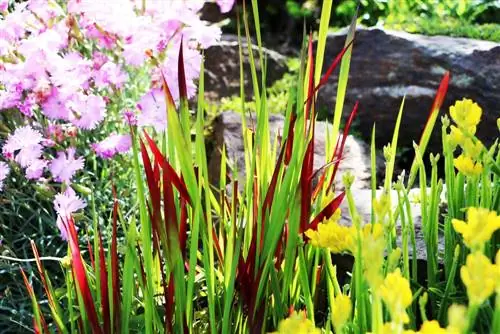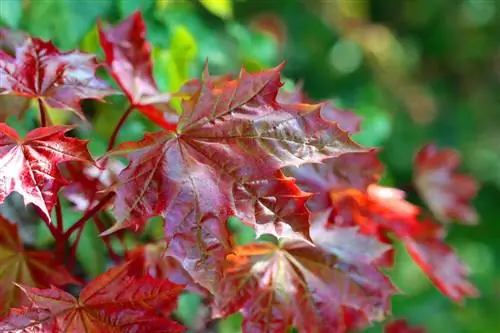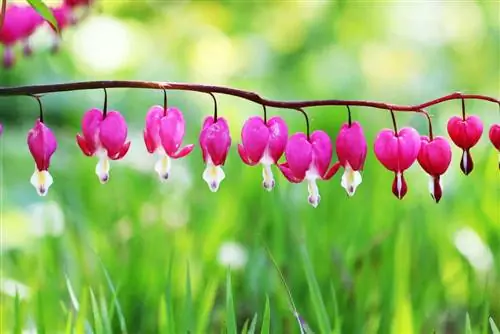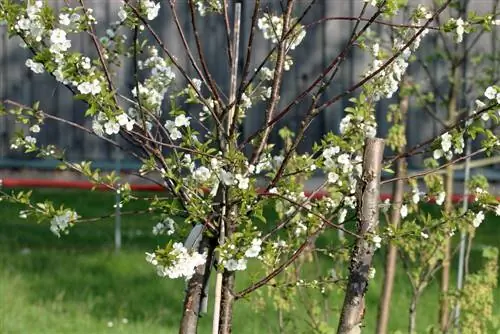- Author admin [email protected].
- Public 2023-12-17 03:39.
- Last modified 2025-06-01 06:48.
The pivotal point in the care of blood grass is professional pruning. The flaming play of colors on the stalks depends on a combination of preparation, timing and cutting. Whether you cultivate the Japanese ornamental grass in a bed or in a bucket also plays a role. This guide explains all aspects in detail.
When is the best time?
In order to determine the right time for pruning, you need to look at the frost resistance of the Japanese ornamental grass variety 'Red Baron'. Since blood grass is assigned to winter hardiness zone Z6, it is considered partially hardy. A sunny, protected location alone is not enough to survive the cold season unscathed. The heart of the plant, which is sensitive to frost, also relies on the stalks to ward off cold and wet conditions. Consequently, the time window for pruning opens in early spring, when severe ground frosts are no longer expected and fresh shoots are imminent. Until then, the stalks act as a natural bulwark against winter hardships, even if they have long since died.
Tip:
In a semi-shady to shady location, you will look in vain for the red-colored stalks. The unique foliage color only develops in full sun, protected locations.
Caution: sharp grass edges
- Tips on tools and equipment -
If you underestimate the sharpness of the leaf edges, the name blood grass takes on a completely different meaning. The 1 to 3 cm wide leaf blades have finely toothed edges that are peppered with silicate crystals. Deep cuts are not uncommon when there is direct skin contact. Gardeners also respectfully refer to the ornamental grass as 'sword grass'. Do not expose yourself to this risk of injury, but always wear sturdy gloves with long cuffs when care and cutting work is on the agenda.
The stiffly upright, defensive stalks are best cut with sturdy, sharp one-handed bypass scissors or a hand saw. Bypass scissors have the advantage that they consist of two sharp blades and leave smooth cuts. In contrast, anvil shears first press the stalks against a blunt surface so that the blade can cut through them. The disadvantage of how it works is that the blades of grass can get caught in the scissors and result in ragged cuts. Fungal spores and pests have just been waiting for this to use the cuts as a portal of entry.
Tip:
Japanese blood grass is only partially hardy north of the Alps. The best time to plant Imperata cylindrica 'Red Baron' is spring. Thanks to this choice of date, a young plant has enough time to root well before the first frost.
Preparation begins in autumn
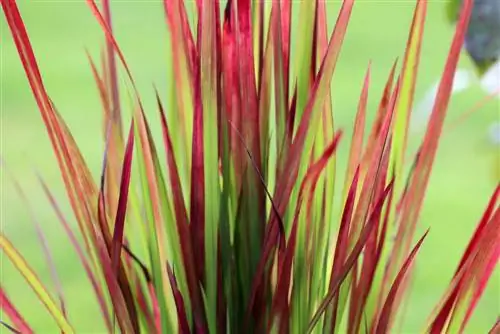
The course is set in autumn for skilful pruning in spring. The following measure aims to protect the inner nest from bitter cold and constant winter wetness. How to do it right:
- Before the first frost, tie the ornamental grass into a loose bunch
- Wrap a small nest with sisal cord
- Tie up a large eyrie into separate bunches
In harsh winter regions, a ring of leaves and brushwood additionally protects the outside of the nest from frost and snow. Only in mild regions, such as the Lower Rhine or in wine-growing regions, does Japanese blood grass prove to be hardy even without this protective measure. In mild climates, you should not be tempted to cut back the ornamental grass in the garden in the fall.
Cutting blood grass in the bed - this is how you do it right
As winter draws to a close, the flame grass has long since ended its furious color festival. By February/March, the deciduous plant has completely drawn in all its stalks. To ensure that the dead plant material does not hinder fresh growth, radical pruning clears the way for the young shoots. Please only use scissors after you have carefully examined the grass nest for feathered or furry winter guests. If animals have chosen the ornamental grass as their winter quarters, postpone the cutting date until the sleepyheads have woken up and moved out. Since Japanese blood grass only sprouts late in the year, you usually don't come into conflict with the sprouts. How to do it professionally:
- Put on gloves and disinfect the tools
- Grip a tuft of grass and cut it close to the ground
- Work gradually from the outer edge to the center
At the end, collect all the stalks that have fallen into the eyrie.
Premature budding in the nest - what should I do now?
As a result of increasing global warming, it is becoming more difficult from year to year to estimate when the growing season will begin in the garden. When pruning ornamental grasses, there is a risk of missing the time of fresh shoots. A cut into the sprouting, green stalks results in brown spots forming at the cuts.
This damage is irreversible and mars the beauty of the flaming discoloration on late summer blood grass. If you were surprised by premature sprouting, this year's pruning will be canceled. Instead, comb out the clump with both hands. You drive through the grass repeatedly to remove all dead stalks. Cut off drawn-in leaves in the edge area close to the ground, as long as they can be reached with the scissors and no green stalks can get between the blades.
Blood grass in the bucket - this is what you should pay attention to
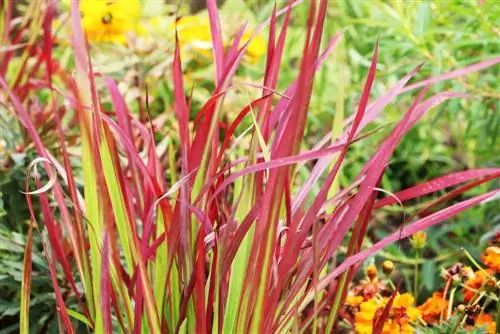
The spectacular hybrid 'Red Baron' is often cultivated in pots to serve as a decorative privacy backdrop on balconies and terraces. The smaller substrate volume compared to the bed noticeably limits frost hardiness. Since the ornamental grass is already categorized as partially hardy outdoors, potted plants should remain in winter quarters during the cold season. Under the protected conditions in a bright, frost-free room, the choice of date for pruning is flexible. You can choose to cut back the stalks before clearing out in the fall, during the winter or after clearing out in the spring.
Recycle clippings cleverly - tips & tricks
The strength properties of Japanese blood grasses have the disadvantage that cuttings on the compost slow down the rotting process considerably. You can reverse this disadvantage if you reuse the cut stalks in the house and garden. The following options have proven themselves well in daily practice:
- Chop up clippings and use as mulch in ornamental and kitchen gardens
- Use whole stalks as a base for fruits that ripen in the ground, such as strawberries or pumpkin
- Use as a loosening admixture to substrates for orchids and other epiphytes
The chopped grass is useful as bedding in animal cages. Horse owners appreciate a larger volume of clippings as box bedding.

